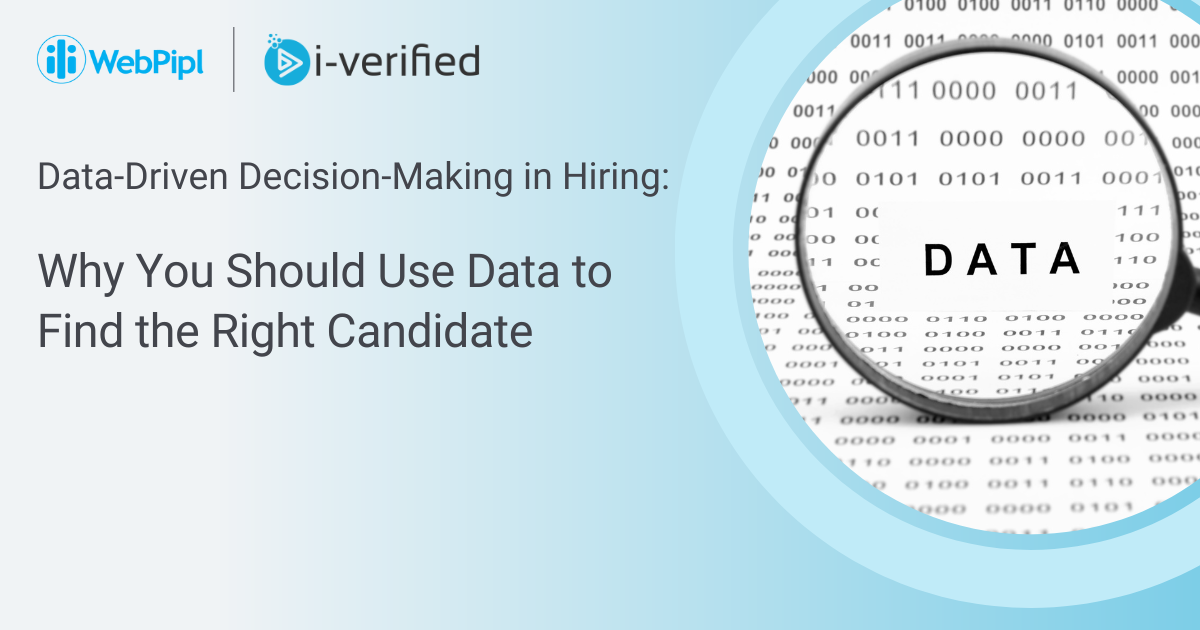
Hiring the right candidate is critical for the success of any organization. Bad hiring can cost a company not just financially but also time and resources. With so much at stake, it’s important to make informed and data-driven decisions when it comes to hiring. By using data to inform hiring decisions, organizations can greatly improve their chances of finding the right candidate for the job.
Data-driven decision-making involves using data to inform and guide the hiring process. This can include data such as resumes, job applications, candidate assessments, and performance metrics. By analysing this data, organizations can gain valuable insights into a candidate’s skills, qualifications, and potential fit for the job.
Benefits of Data-Driven Hiring
 The benefits of using data to make hiring decisions are multitude.
The benefits of using data to make hiring decisions are multitude.
- Improve the accuracy of hiring decisions: By relying on data rather than intuition or bias, organizations can ensure that they are selecting the most qualified and suitable candidate for the job.
- Automating the hiring process: Secondly, data-driven hiring can save time and resources. By automating parts of the hiring process and using data to screen and rank candidates, organizations can streamline the hiring process and reduce the time and costs associated with hiring.
- Diversity & Inclusion: Furthermore, data-driven hiring can improve diversity and inclusion in the workplace. By removing bias and relying on data to make hiring decisions, organizations can ensure that they are selecting the best candidate regardless of factors such as gender, race, or ethnicity.
- Employee Retention: Finally, data-driven decision-making in hiring can also improve employee retention. By selecting the right candidate for the job, organizations can improve job satisfaction and reduce turnover rates, resulting in a more stable and successful organization.
As the job market becomes more competitive and the need for top talent becomes more pressing, data-driven hiring will continue to be a key strategy for successful organizations.
Identifying the Right ‘Data-Driven’ Candidate
 Despite multitude benefits, hiring is a daunting task, as employers face various challenges, such as:
Despite multitude benefits, hiring is a daunting task, as employers face various challenges, such as:
- identifying the right skills,
- cultural fit, and
- experience.
In a highly competitive job market, selecting the right candidate can have a significant impact on the success of an organization.
Data-driven decision-making in hiring can be a game-changer for employers. By using data analytics, employers can easily identify the required skills, qualifications, and traits needed for the job. Predictive analytics can help identify the candidate’s potential to succeed in the role.
Many companies have already started using data analytics to identify the right candidate for the job. For example, Amazon uses data to identify the most successful salespeople, and Google uses data to identify the most productive employees. The use of data analytics in identifying the right candidate has proved to be highly effective, leading to better hiring decisions and successful outcomes.
By using data analytics, employers can make informed decisions, leading to better hiring outcomes and overall organizational success.
Eliminating Bias
 Bias in the hiring process can lead to discrimination and limit diversity in the workplace. Data can be used to eliminate bias by creating an objective process that focuses on the skills and qualifications of the candidate. By using data to analyze job descriptions, resumes, and interview responses, companies can identify and eliminate any unconscious biases that may be present.
Bias in the hiring process can lead to discrimination and limit diversity in the workplace. Data can be used to eliminate bias by creating an objective process that focuses on the skills and qualifications of the candidate. By using data to analyze job descriptions, resumes, and interview responses, companies can identify and eliminate any unconscious biases that may be present.
For example, Companies have the ability to utilize algorithms that can eliminate personal identification details, like name, age, gender, and ethnicity, from job applications and cover letters. This helps to decrease the influence of unconscious biases during the recruitment process.
Data can also be used to measure the effectiveness of hiring strategies and identify any areas where bias may still exist.
Streamlining the Hiring Process
The traditional hiring process can be time-consuming and resource-intensive. Data can be used to streamline the process by automating certain tasks and identifying the most efficient ways to find and attract qualified candidates. For example, companies can use data to create targeted job postings that reach the right candidates based on their skills and qualifications.
Data can also be used to predict which candidates are most likely to accept a job offer and to identify the best channels for sourcing candidates. By using data to streamline the hiring process, companies can save time and money while also improving the quality of their hires.
For instance, a survey conducted by SHRM found that the average cost per hire is $4,129, and the average time to fill a position is 42 days. By using recruitment technology that streamlines the hiring process, companies can significantly reduce these costs and time-to-fill metrics while also improving the quality of their hires.
Reducing Turnover Rates
 “Turnover rates” refer to the proportion of employees who leave a company over a certain period of time, often measured as a percentage of the total number of employees. High turnover rates can be costly for companies in terms of lost productivity, training, and recruiting expenses. Data can help reduce turnover rates by identifying the reasons why employees are leaving and developing strategies to address those issues.
“Turnover rates” refer to the proportion of employees who leave a company over a certain period of time, often measured as a percentage of the total number of employees. High turnover rates can be costly for companies in terms of lost productivity, training, and recruiting expenses. Data can help reduce turnover rates by identifying the reasons why employees are leaving and developing strategies to address those issues.
For example, companies can use data to identify common characteristics of employees who stay with the company long-term and use that information to create a profile of the ideal candidate. Data can also be used to measure employee satisfaction and identify areas where improvements can be made. By using data to reduce turnover rates, companies can create a more stable and productive workforce.
Transform Your Hiring Process with Data-Driven Decision Making
In today’s competitive job market, it’s more important than ever to hire the right candidates quickly and efficiently. Using data-driven decision-making in hiring can help companies identify the right candidates, eliminate bias, streamline the hiring process, and reduce turnover rates.
By embracing data, companies can make better decisions, improve their hiring strategies, and create a more diverse and productive workforce. We encourage all companies to start using data in their hiring process to stay ahead of the competition and achieve their business goals.
If you’re not already using data to make hiring decisions, it’s time to start! Ready to embrace data-driven hiring and achieve your business goals? Start using iVerified today!

Raju Thammala is the founder of WebPipl, an AI-based recruitment company revolutionizing the tech hiring process with products like video interviews, ATS software, etc.
As CEO and founder, Raju Thammala is passionate about leveraging technology to deliver next-gen recruiting services. In his free time, Raju enjoys reading and exploring new cuisines or jet-setting to exotic destinations.
